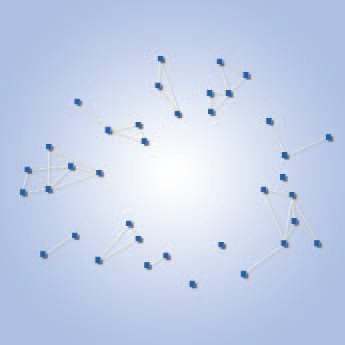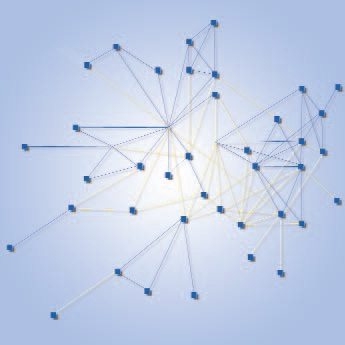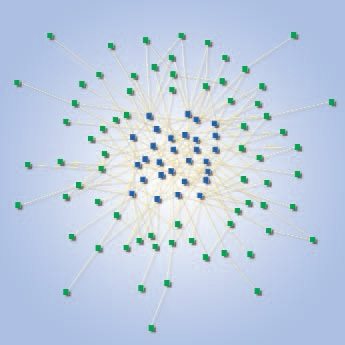Editors’ Note: This is an article that focuses on the basic phases of building effective networks, using one grounded example to bring the theory to life. We recommend that readers look back also at Carl Sussman’s article (see Winter 2003, “Making Change: How to Build Adaptive Capacity”) and think about how the two approaches relate to one another in the achievement of real change.
Communities are built on connections. Better connections usually provide better opportunities. But, what are better connections, and how do they lead to more effective and productive communities? How do we build connected communities that create, and take advantage of, opportunities in their region or marketplace? How does success emerge from the complex interactions within communities?
This article investigates building adapt ive and agi le communit ies through improving their connectivity— internally and externally—using network ties to create economic opportunities. Improved connectivity is created through an iterative process of knowing the network and knitting the network.
Know the Net
Improved connectivity starts with a map—knowing the complex human system you are embedded in. The Appalachian Center for Economic Networks [ACEnet], a regional economic development organization in Athens, Ohio has long followed the connectivity mantra—create effective networks for individual, group and regional growth and vitality. Recently ACEnet has begun to map and measure the social and economic connections it helped create in the grassroots food industry in Southeast Ohio. Network maps provide a revealing snapshot of a business ecosystem at a particular point in time. These maps can help answer many key questions in the community-building process.
- Are the right connections in place? Are any key connections missing?
- Who’s playing a leadership role in the community? Who is not, but should be? • Who are the experts in the area?
- Who are the mentors that others seek out for advice?
- Who are the innovators? Are ideas shared and acted upon?
- Are collaborative alliances forming between local businesses?
- Which businesses will provide a better return-on-investment—both for themselves and the community they are embedded in?
These are all important questions that ACEnet seeks to answer in order to help build a more vibrant economy in Appalachian Ohio.
| ACEnet, founded in 1985, provides a wide range of assistance to food, wood, and technology entrepreneurs in 29 counties of Appalachian Ohio. This region has some of the highest poverty and unemployment rates in the country, and ACEnet works with communities throughout the region who want to improve their support for entrepreneurs as a means to provide more local ownership and higher quality jobs. |
Before you can improve your network, you need to know where you are currently—the “as is” picture. A network map shows the nodes and links in the network.
- Nodes can be people, groups, or organizations.
- Links show relationships, flows, or transactions. A link can be directional. A network map is an excellent tool for visually tracking your ties and designing strategies to create new connections. It can also be an excellent “talking document”—a visual representation that opens up many conversations about possibilities.
The transformation required to achieve healthy communities is the result of many collaborations among network nodes. Complexity scientists describe this phenomenon—where local interactions lead to global patterns— as emergence. This is how good local ideas are improved upon and brought to scale. We can guide emergence by understanding and catalyzing connections. For example, knowing where the connections are, and are not, allows a community development organization to influence local interactions. This is particularly important in policy networks where key nodes play an important role in what flows throughout the network. Influencing a smal l number of well-connected nodes often results in better outcomes than trying to access the top person or calling on random players in the policy network. If you know the network, you can better focus your influencing activities.
What Does a Vibrant, Effective Community Network Look Like?
Research has been done to discover the qualities of vibrant networks. Sociologists, physicists, mathematicians, and management consultants have all discovered similar answers about effective networks. The amazing discovery is that people in organizations, routers on the internet, cells in a nervous system, molecules in protein interactions, animals in an ecosystem, and pages on the Web are all organized in efficient network structures that have similar properties.
Five general patterns are observed in all effective networks:
- Birds of a feather flock together: nodes link together because of common attributes, goals, or governance.
- At the same time, diversity is important. Though clusters form around common attributes and goals, vibrant networks maintain connections to diverse nodes and clusters. A diversity of connections is required to maximize innovation in the network.
- Robust networks have several paths between any two nodes. If several nodes or links are damaged or removed, other pathways exist for uninterrupted information flow between the remaining nodes.
- The average path length1 in the network tends to be short without forcing direct connections between every node. The power of the indirect2 tie is used.
- Some nodes are more prominent than others—they are either hubs,3 brokers,4 or boundary spanners.5 They are critical to network health.
Network Neglect Can Lead to Devolution
Even though we know several keys to building effective networks, this knowledge is rarely put to use. Networks, whether social or business, are usually left to grow without a plan. When left unmanaged, networks follow two simple, yet powerful driving forces:
- Birds of a feather flock together.
- Those close by, form a tie.
| Recently ACEnet Food Ventures staff asked area entrepreneurs and organizations, “From whom do you get new ideas that benefit your work?”“From whom do you access expertise that improves your operations?” and “With whom do you collaborate?” The answers to these questions were mapped using Valdis Krebs’ InFlow™ social network mapping software into an Innovation Network, an Expertise Network, and a Collaboration Network. Analyzing these networks led team members to realize that there were several entrepreneurs who played a critical role in the food sector, but with whom they had little relationship. The team developed a strategy for more explicitly working with these entrepreneurs by asking them to conduct workshops for other entrepreneurs in which they could learn about their needs for business assistance. |
This results in many small and dense clusters with little or no diversity. Everyone in the cluster knows what everyone else knows and no one knows what is going on in other clusters. The lack of outside information, and dense cohesion within the network, removes all possibility for new ideas and innovations. We see this in isolated rural communities that are resistant to change, or in a classic “old boy” network. Yet, the dense connections, and high degree of commonality forms good work groups—clusters of people who can work together smoothly.
Instead of allowing networks to evolve without direction, successful individuals, groups, and organizations have found that it pays to actively manage their network. Using the latest research, we can now knit networks to create productive individuals and smart communities.

FIGURE 1—SCATTERED EMERGENCE
Knit the Net
A vibrant community network is generally built in four phases, each with its own distinct topology. Each phase builds a more adaptive and resilient network structure than the prior phase. Network mapping can be used to track your progress through these four stages.
- Scattered Emergence
- Single Hub-and-Spoke
- Multi-Hub Small-World Network
- Core/Periphery
Scattered Emergence
Experience shows that most communities start as small, emergent clusters organized around common interests or goals. Usually these clusters are isolated from each other. They are very small groups of 1–5 people or organizations that have connected out of necessity (see Figure 1). If these clusters do not organize further, the community structure remains weak and under-productive.
Without active leaders who take responsibility for building networks, spontaneous connections between groups emerge very slowly, or not at all. We call this leadership role a network weaver.6 Instead of allowing these small clusters to drift, in the hope of making a lucky connection, the weavers actively create new interactions between the clusters.
Hub and Spoke
The first network a weaver creates is the hub-and-spoke model, with the weaver as the hub. The weaver has the vision, the energy, and the social skills to connect to diverse individuals and groups and start information flowing to and from them. The weaver usually has external links outside of the community to bring in resources and innovation. This is a critical phase for community building because everything depends on the weaver who is the lone hub in the network. However, if multiple weavers are working in the same community, we may get multiple hub and spoke networks, with some overlap between all of them. Figure 2 shows the weaver connecting the previously scattered little clusters.
Initially the network weaver forms relationships with each of the small clusters. During this phase the weaver is learning about each individual or small cluster—discovering what it knows and what it needs. However, the hub-and-spoke model is only a temporary step in community growth. It should not be utilized for long because it concentrates both power and vulnerability in one node—the hub. If the lead organization/weaver fails or leaves, then we are back to the disconnected community in Figure 1.
In healthy network weaving, the spokes of the hub do not remain separated for long. The weaver begins connecting those individuals and clusters who can collaborate or assist one another in some way. Concurrently, the weaver begins encouraging others to begin weaving the network as well. Even though it is a temporary structure, the hub-and-spoke model is usually the best topology to bring together the scattered clusters seen in most immature communities. An organization with a vision, and contacts to external ideas and resources, can play the role of the hub. This is the role ACEnet took up when it saw that SE Ohio was home to many small, uncoordinated food clusters. There was the Farmer’s Market crowd, the natural bakery, a worker-owned Mexican restaurant and a few other entrepreneurs creating unique food products. ACEnet brought all of these unconnected groups together around a kitchen incubator—a state-of-the-art facility for preparing and packaging a large variety of food items.
Multi-Hub Small World Network
| When ACEnet decided to build a Kitchen Incubator—a licensed processing facility where entrepreneurs could rent the use of ovens, stoves and a processing line to produce their products—they used the need to design the incubator as an opportunity to link small clusters. For example, for one design session they brought people from the town’s restaurants together with small farmers who wanted to turn their produce into value-added products. Farmers were able to learn about food-production safety from the restauranteurs who explained how these procedures could be incorporated into the incubator. Some of the farmers also used the opportunity to sell their produce to the restaurants, which were always on the lookout for unique raw materials. And, an unexpected bonus was that the restaurants realized that they could use the Kitchen Incubator’s storage warehousefor large orders from their suppliers, thus making the incubator an important resource within the network. |
As the weaver connects to many groups, information is soon flowing into the weaver about each group’s skills and goals. An astute weaver can now start to introduce clusters that have common goals/interests or complementary skills. As clusters connect, their spokes to the hub can weaken, freeing up the weaver to attach to new groups. Although the spoke links weaken, they never disappear—they remain weaker, dormant ties, able to be re-activated whenever necessary. In order to accommodate new connections, the weaver must teach its early connections how to weave their own network. Training in network building is important at this juncture. Network mapping reveals the progress and identifies emerging network weavers.
This happened with ACEnet as several of the businesses and small nonprofit s began to build thei r own network neighborhood, bringing new nodes and links into the early Athens community network. As the overall network grows, the role of the weaver changes from being the central weaver, to being a facilitator in the community— coordinating with, and mentoring of other network weavers.
Sign up for our free newsletters
Subscribe to NPQ's newsletters to have our top stories delivered directly to your inbox.
By signing up, you agree to our privacy policy and terms of use, and to receive messages from NPQ and our partners.

FIGURE 2—HUB-AND-SPOKE NETWORK
There are two parts to network weaving. One is relationship building, particularly across traditional divides, which gives people access to innovation and important information. The second is learning how to facilitate collaborations for mutual benefit. Collaborations can vary from simple and short-term, e.g., entrepreneurs purchasing supplies together, to complex and long-term, such as a major policy initiative or the creation of a venture fund. This culture of collaboration creates a state of emergence, where the outcome—a healthy community—is more than the sum of the many collaborations. The local interactions create a global outcome that no one could accomplish alone.
Network weaving is not just “networking,” nor schmoozing, nor handing out business cards. Weaving brings people together for projects, initially small, so they can learn to collaborate. Through that collaboration they strengthen the community and increase the knowledge available in it. After working with the authors, Jack Ricchiuto, a Cleveland-based management consultant and author, created a pyramid of network weaving involvement. Level 1 is a “networking” type interaction, while levels 6 and 7 are highly involved commitments to building community. A majority of ACEnet’s larger successes fall under the two top levels [6 & 7] of Ricchiuto’s Pyramid [1].
| Level | Activity |
| 7 | Introducing A to B in person and offering a collaboration opportunity to get A and B off to a successful partnership |
| 6 | Introducing A to B in person and following up with A and B to nurture connection |
| 5 | Introducing A to B in person |
| 4 | Introducing A to B in a conference call |
| 3 | Introducing A to B in an email |
| 2 | Suggesting A talk to B and calling B to look for a contact |
| 1 | Suggesting to A that A should talk to B |
This transition from network weaver to network facilitator is critical. The original weaver is identifying and mentoring new weavers who will eventually take over much of the network building and maintenance. If this transition is not made, then the community network remains dependent on the central weaver and their organization. At the transition point, the weaver changes from being a direct leader to an indirect leader, influencing new emergent leaders appearing throughout the community. This transition is necessary for the network to increase its scale, impact, and reach.
Moving from a single-hub topology to a multi-hub topology with its many advantages. The first advantage of a multi-hub topology is that it eliminates having a single point of failure. ACEnet is still a dominant hub in SE Ohio, and its failure would affect the region greatly—but not as significantly as five years ago when the network was spar ser and more dependent on ACEnet. Now ACEnet has the luxury of spending time in new pursuits such as teaching others to knit their nets, and expanding the network to other areas inside and outside of Appalachia.
| To bring in new ideas from outside the region, ACEnet has developed several “innovation learning clusters”that bring together leading-edge organizations from around the country that share their innovations with each other. ACEnet staff that participate bring information about those innovations back to the region and adapt them to the local environment. For example, Larry Fisher, one of ACEnet’s directors, participates in a rural entrepreneurship policy cluster where he learned the basics of building a policy network from organizations that had many years of experience. He is now leading ACEnet’s efforts to change the policy of local counties, making it more supportive of entrepreneurship; and he can move forward with a more sure hand since he is building on the experience of others, whom he can contact when he has questions. |
As the weaver connects various individuals, organizations and clusters, these entities connect to each other loosely. A new dynamic is revealed here—the strength of “weak ties.” Weak ties are connections that are not as frequent, intense, or resilient as the strong network ties that form the backbone of a network. Strong ties are usually found within a network cluster, while weak ties are found between clusters. As clusters begin to connect, the first bridging links are usually weak ties.

FIGURE 3—MULTI-HUB, SMALL-WORLD NETWORK
Bridging ties between clusters are important to innovation. New ideas are often discovered outside the local domain. To get transformative ideas you often have go outside of your group. A successful formula for creating ties for innovation is to find other groups that are both similar to and different from your own. Similarity helps build trust, while diversity introduces new ideas and perspectives. Connect on your similarity, and profit from your diversity.
Now that other hubs [network weavers] are emerging in the network, the various weavers begin to connect to each other, creating a multi-hub community. Not only is this topology less fragile, it is also the best design to minimize the average path length throughout the network—remember , the shorter the hops, the better for work flow, information exchange and knowledge sharing! Information percolates most quickly through a network where the best-connected hubs are all connected to each other. A network with many hubs is also very resilient and cannot be easily dismantled.
Next comes a multi-hub, small-world network, illustrated in Figure 3. Here, four clusters have created many weak ties to each other. The weak ties may or may note become stronger to create one tightly coupled larger cluster. The multiple hubs can be small businesses or other community development organizations. Initially, the ACEnet Kitchen Incubator was a major gathering place, a physical network hub, where people ran into each other, hung around to talk, and often cooked up some kind of deal, e.g., joint orders of jars so they could get a cheaper price, an arrangement to jointly market their products, or an agreement to trade labor on a project.
The impor tant next step i s to strengthen some of the weak ties in the network so they become strong ties. However, a multi-hub network may be difficult to achieve if political and “turf” issues are raging through the network, so these need to be handled early in the process in order for the network to emerge effectively. If two or more community development organizations start battling over turf and control of the community, the result may be two or more competing, single-hub networks that ignore the larger community needs and focus on the survival of their own network.
| Initially, the ACEnet Kitchen Incubator was a major gathering place, a physical network hub, where people ran into each other, hung around to talk, and often cooked up some kind of deal: joint orders of jars so they could get a cheaper price, an arrangement to jointly market their products, or an agreement to trade labor on a project. However, after a few years, many other network hubs popped up. For example, the Athens Farmers’ Market hosted more than 90 farmers and local food vendors who networked with each other and their avid customers. Several years ago, four local organizations set up a Farmers’Market Café that provided tables and chairs under tents so that people could hang around longer and network with more neighbors. Casa Neuva, a worker-owned Mexican restaurant, is not only a networking hub, but has played a major role in organizing most of the locally owned restaurants into the Athens Independent Restaurant Association, a group that donates money each month to community nonprofits and is increasing the amount of produce and locally processed goods that restaurants purchase from local farm families. Six miles outside town, more than 200 people flock on Saturdays to enjoy fresh baked focaccia, pastries, and hearth bread on the outdoor terrace outside the Big Chimney Bakery. The proprietor is a major network hub himself, who helps new entrepreneurs develop their recipes and learn strategy from a pro. |
The Core/Periphery Network
The end-goal for vibrant, sustainable community networks is the core/periphery model. This topology emerges after many years of network weaving by multiple hubs. It is a stable structure that can link to other well-developed networks in other regions. The network core in this model contains the key community members, including many who are network weavers, who have developed strong ties between themselves. The periphery of this network contains three groups of nodes that are usually tied to the core through looser ties.
- Those new to the community and working to get to the core
- Bridges to diverse communities elsewhere
- Unique resources that operate outside of the community, and may span many communities

FIGURE 4—CORE / PERIPHERY NETWORK
The economic landscape is full of imperfectly shared ideas and information. The periphery is the open, porous boundary of the community network where new members/ideas come and go. The periphery allows us to reach ideas and information not currently prevalent in the network, while the core allows us to act on those ideas and information. The periphery monitors the environment, while the core implements what is discovered and deemed useful.
Figure 4 shows a well-developed core/periphery structure. The blue nodes are the core, while the green nodes reside in the periphery. This network core is very dense;7 not all cores will have as high a concentration of connections as this one. Too much density can lead to rigidity and an overload of activity. Monitoring your network using social network analysis can help you see where your network needs to shift connections to match the current environment.
At this point, the network weavers’ initial tasks are mostly completed. Now, attention turns toward network maintenance and building bridges to other networks. The network weavers can begin to form inter-regional alliances to create new products, services and markets—or to shape and influence policy that will strengthen the community or region. This happens by connecting network cores to each other utilizing their peripheries. The network weavers maximize the reach of the periphery into new areas, while keeping the core strong. The weavers now focus on multi-core projects that will have major impact on the community.
| ACEnet has helped form the Appalachian Ohio Regional Investment Coalition (AORIC) which includes another community organization, a regional foundation, the Ohio Arts Council, and an Ohio University–based institute. AORIC is now mobilizing a large network of organizations interested in supporting entrepreneurs as a way to create a healthier regional economy. This network is reaching deep into communities to identify the barriers entrepreneurs face, and then to collaborate on projects that will develop new supportive infrastructure to increase their success. |
Conclusion
As we have seen, weaving a network requires two iterative and continuous steps:
- Know the network—take regular snapshots of your network and evaluate your progress.
- Knit the network—follow the fourphase network knitting process.
All throughout this process network maps guide the way—they reveal what we know about the network and they uncover possible next steps for the weaver.
Starting with a disconnected community, network builders can start weaving together the necessary skills and resources to build simple, singlehub networks. This will be followed by a more efficient and resilient multi-hub network, finishing with a sustainable core/periphery structure. Once the network is strong, it can connect to other distant community networks to create more opportunities.
End Notes
1. The average path length in a network is a convenient measure of the network’s global efficiency. The longer the average path length, the longer it takes for messages to travel between any two nodes, and the more distorted they are when they arrive.
2. An indirect tie is a network path that connects two nodes through on or more intermediaries. Here A and B, and B and C have direct ties while A and C have an indirect tie through the intermediary B. A–B–C
3. Nodes with many direct connections that quickly disperse information.
4. Nodes that connect otherwise disconnected parts of the network—they act as liaisons.
5. Nodes that connect two or more clusters— they act as bridges between groups.
6. While the Athens food network focused on one network weaving organization—ACEnet, there were actually several individual network weavers within ACEnet. Each network weaver within ACEnet had a particular focus. They all worked with a common vision. If several network weavers are present and willing to collaborate, increased progress is possible.
7. Network density is calculated by the number of existing connections as a percentage of the total possible.
VALDIS KREBS is a management consultant and the developer of InFlow social network analysis software (valdis@orgnet.com, www.orgnet.com). JUNE HOLLEY is founder and President/ CEO of the Appalachian Center for Economic Networks (juneh@acenetworks. org, www.acenetworks.org). Contact June or Valdis for information on their workshop on network weaving.











